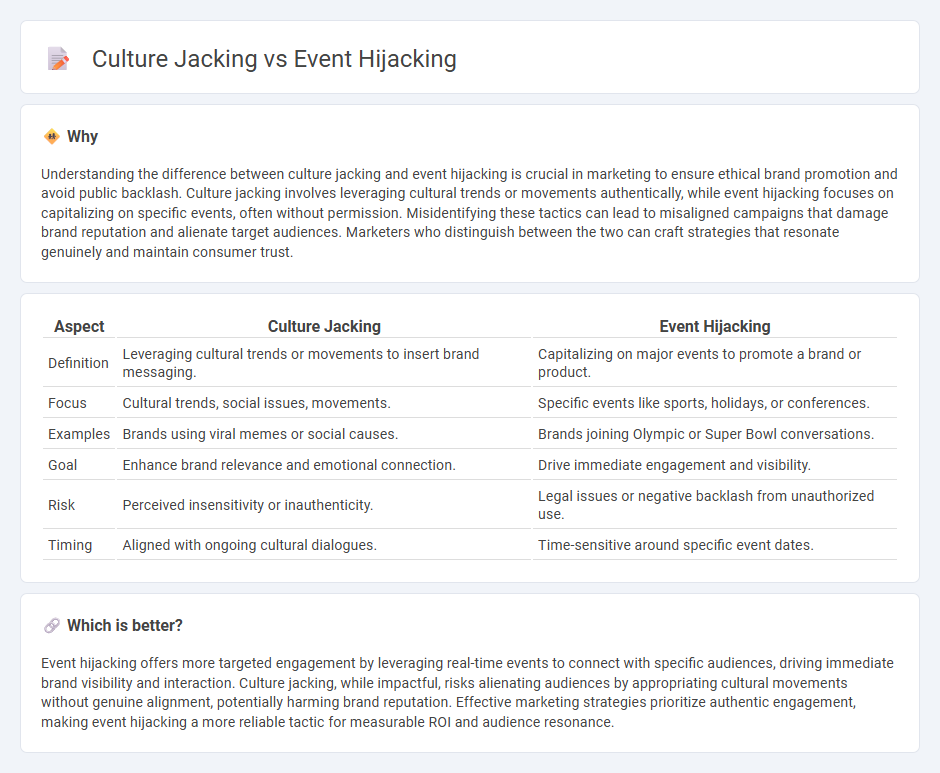
Culture jacking involves aligning marketing campaigns with current cultural trends to engage audiences authentically, while event hijacking focuses on leveraging ongoing events to capture attention and drive brand visibility. Both strategies require precise timing and deep understanding of audience sentiment to maximize impact. Explore the nuances of culture jacking and event hijacking to enhance your marketing effectiveness.
Why it is important
Understanding the difference between culture jacking and event hijacking is crucial in marketing to ensure ethical brand promotion and avoid public backlash. Culture jacking involves leveraging cultural trends or movements authentically, while event hijacking focuses on capitalizing on specific events, often without permission. Misidentifying these tactics can lead to misaligned campaigns that damage brand reputation and alienate target audiences. Marketers who distinguish between the two can craft strategies that resonate genuinely and maintain consumer trust.
Comparison Table
| Aspect | Culture Jacking | Event Hijacking |
|---|---|---|
| Definition | Leveraging cultural trends or movements to insert brand messaging. | Capitalizing on major events to promote a brand or product. |
| Focus | Cultural trends, social issues, movements. | Specific events like sports, holidays, or conferences. |
| Examples | Brands using viral memes or social causes. | Brands joining Olympic or Super Bowl conversations. |
| Goal | Enhance brand relevance and emotional connection. | Drive immediate engagement and visibility. |
| Risk | Perceived insensitivity or inauthenticity. | Legal issues or negative backlash from unauthorized use. |
| Timing | Aligned with ongoing cultural dialogues. | Time-sensitive around specific event dates. |
Which is better?
Event hijacking offers more targeted engagement by leveraging real-time events to connect with specific audiences, driving immediate brand visibility and interaction. Culture jacking, while impactful, risks alienating audiences by appropriating cultural movements without genuine alignment, potentially harming brand reputation. Effective marketing strategies prioritize authentic engagement, making event hijacking a more reliable tactic for measurable ROI and audience resonance.
Connection
Culture jacking and event hijacking both leverage trending cultural moments or popular events to amplify brand visibility and engage target audiences. These marketing strategies capitalize on existing public interest by infusing relevant messaging or creative content that resonates with the cultural or event context. By aligning with timely themes, brands can enhance consumer connection and drive viral reach without traditional advertising.
Key Terms
**Event Hijacking:**
Event hijacking involves brands or individuals capitalizing on the popularity of a major event without official affiliation, aiming to gain visibility and engagement by associating with trending topics or hashtags. This strategy often leverages live events such as sports games, political debates, or award shows to insert messages that resonate with the event's audience. Explore how event hijacking can impact brand perception and marketing effectiveness in competitive landscapes.
Real-time Marketing
Event hijacking involves brands leveraging major live events to insert their message, often by real-time responses aligned with the event's theme to capture audience attention. Culture jacking extends beyond isolated events by tapping into ongoing cultural trends and societal conversations, enabling brands to engage dynamically with evolving public sentiments. Discover more insights on how real-time marketing strategies can amplify brand presence through these techniques.
Trending Events
Event hijacking involves brands or individuals leveraging the popularity of trending events to promote unrelated messages or products, often without official endorsement. Culture jacking targets cultural moments or societal trends, embedding marketing efforts into the broader cultural conversation to enhance relatability and engagement. Explore how strategic use of trending events can amplify brand visibility and consumer connection.
Source and External Links
Max Headroom signal hijacking - Wikipedia - The Max Headroom signal hijacking was a notorious 1987 incident in Chicago where unknown individuals briefly took over TV broadcasts of two stations, interrupting normal programming with bizarre, unauthorized video clips featuring a person in a Max Headroom mask.
Broadcast signal intrusion - Wikipedia - Broadcast signal intrusion refers to the unauthorized hijacking of radio, television, cable, or satellite signals, often achieved by overpowering the original broadcast with a stronger transmitter or direct physical tampering with equipment.
Hijacking B2B Industry Events - Positioning Playbook - In marketing, "event hijacking" describes guerrilla tactics where companies bypass official event channels to creatively capture audience attention and leverage the event's platform without formal participation or sponsorship.
 dowidth.com
dowidth.com